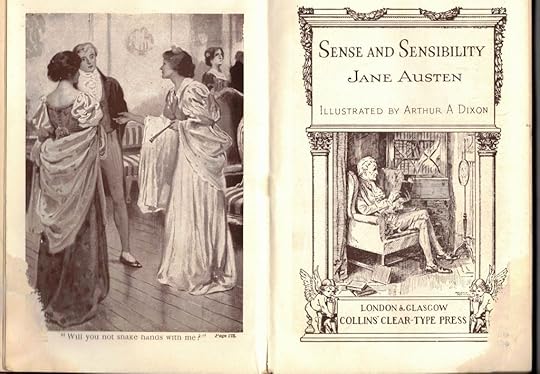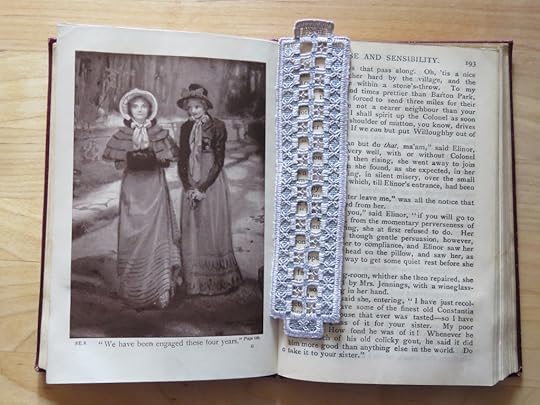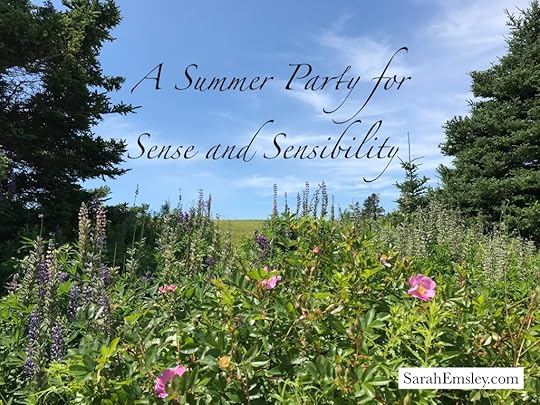Re-Reading Sense and Sensibility, by Sandra Barry
The first time I read any Jane Austen was in Grade 10 (1976-1977) at Bridgetown Regional High School, in Bridgetown, Nova Scotia. My English Literature teacher was Miss Ellen Corkum, fresh out of Teacher’s College and a favourite among the senior high students. She was a wonderful teacher, enthusiastic about literature, who encouraged us to think creatively about what we were reading. The project I did was on Austen’s Pride and Prejudice. I am sure I wrote an essay, but what I remember most is spending weeks scouring magazines for images that somehow, in my view, represented the main characters. Then I created collages using the images. I remember cutting out pictures and words, arranging them on Bristol board, and meticulously lettering in the names of each character.
I suppose my essay was a kind of character analysis and the collages were a graphic complement to my words—so, a multi-media approach before I ever knew such a term. (Remember, there were no computers then, only magazines, scissors, glue and imagination.) I made collages for all the sisters, the parents and, of course, Mr. Darcy, with whom I fell in love! I remember feeling proud of my effort and I kept the collages for a long time. They are long gone now, lost in the drift of space-time. Even so, they remain vivid in my memory. I got an A. (Even the school itself is now gone, torn down, and nearby a new, state-of-the-art K-12 facility built, filled, I am sure, with computers and other wonders of modern technology.)

(From Sarah: This is the twenty-first guest post in “A Summer Party for Sense and Sensibility,” which began on June 20th and will continue through to the end of the summer. You can find all the contributions to the blog series here . I hope you’ll join the conversations about S&S in the comments here and on social media: #senseandsensibilitysummer. Thanks for celebrating Jane Austen’s first published novel with us!)
The long-term impact of this introduction was my intention to—outside any school requirement—read every Austen novel, some borrowed from the school library and some from the tiny public library in town. Eventually, I bought the Penguin paperback editions of all of Austen’s novels. (Alas, periodic culls of my library over the decades have meant that I passed on these volumes.) I do not remember when I first read Sense and Sensibility, but it was during my late teens or early twenties.
The other major impact of reading Austen was that it sent me on to the Brontës, Eliot, Dickens, James and other mid-19th century novelists. I progressed through the late-1800s until I reached an immersion in Woolf, whom I did study at university. But it all started with Austen and my fifteen-year-old self.

When Sarah invited me to write a guest post to help celebrate Sense and Sensibility, I was honoured and happy to agree, but it had been decades since I had read any Austen, being immersed as I have been for over thirty years in writing about the life and work of the poet Elizabeth Bishop. However, about two years ago, my sister Brenda (whose photos Sarah has shared on this blog and are in this post), also a big Austen fan, coincidentally found and bought a lovely little edition of this novel at a wonderful used bookstore in Bridgetown, Endless Shores.
The volume is a Collins’ Clear-Type Press edition out of London and Glasgow, illustrated by Arthur A. Dixon. There is no publication date, but a rudimentary online search suggests it was published just after the turn of the 20th century, the time when Dixon was most active. It is a dear little book, only 6” x 4” with a leather cover, gold embossed words on the spine, onion skin paper and seven sepia illustrations: a lovely object to hold, just the kind of book one of Austen’s characters might hold and read in the evening in the drawing room. When Sarah invited me to contribute something, I picked it up and began to re-read it, at least four decades after first doing so.

In the interim my main Austen intake has been the movie and television adaptations of her books. I’ve lost track of how many we have watched (some better than others, and we have watched our favourite adaptations over and over again). So, it was a revelation to go back to the original words.

The primary revelation in this return was how leisurely the novel is, compared to the compression that must happen when translating to the screen. My perceptions of the characters were also challenged, so fixed have they become through the cinematic lens so ubiquitous these days.
I purposely re-read Sense and Sensibility slowly, a chapter a day, so I could ponder its quietly unfolding narrative. I could see where film-makers had lifted lines verbatim, removing them from Austen’s lush contexts. As I progressed, I tried to clear away the interpretations wrought by script writers, directors and producers. All readers bring their own sensibilities to any text (projecting, selecting, interpreting) and I wanted to let my own responses apply. And also, simply enjoy Austen’s charming, intricate, intelligent language.

Perhaps the most startling revelation for me came late, with the encounter between Elinor and the by then unhappily married Willoughby (while Marianne is still recovering). I had not remembered at all his long, self-serving explanation about his behaviour, his plea to be seen as one of the victims, his justifications which go on for pages—and Elinor’s patience and inclination, not fully conceded, to feel sorry for him. Forgive me for bringing my 21st-century sensibility to his egotistical moan: I mean, really Willoughby! It is a testament to Austen’s own keen sense of human behaviour and experience that the “happy ending” offered happens in the quietest of ways, almost as an afterthought.

I guess the question for me now is which Austen novel will I re-read next?

Sandra Barry is a poet, independent scholar and freelance editor. She is one of the founders of the Elizabeth Bishop Society of Nova Scotia and her book Elizabeth Bishop: Nova Scotia’s ‘Home-Made’ Poet was published by Nimbus in 2011. She and her sister Brenda spent last week at the Elizabeth Bishop House in Great Village, NS, where they had “time to sit for long stretches on the verandah and watch the sky and clouds and back pasture with its deer and birds.” Here’s a photo of that view, taken by Brenda:

This photo of Sandra (on the left) with Brenda and their friend Pam was taken by Greg Riley.

If you enjoyed this post, I hope you’ll consider recommending it to a friend. If you aren’t yet a subscriber, please sign up to receive future guest posts in “A Summer Party for Sense and Sensibility.” The next post, “Sense and Sensibility Hearkens Back to Its Origins,” is by Collins Hemingway.

Here are the links to the last two posts, in case you missed them:
Writing the Musical: Sense and Sensibility, by Paul Gordon
A Song Can Sing So Much, by Lori Mulligan Davis

Read more about my books, including Jane Austen’s Philosophy of the Virtues and Jane Austen and the North Atlantic, here.



